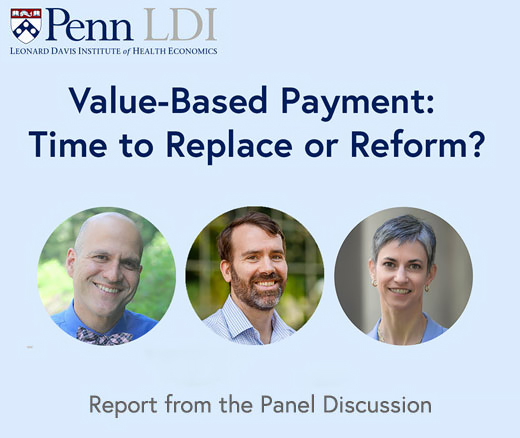
Black Older Adults With Cancer Are Far Less Likely to Get Any Care
New Study From LDI and MD Anderson Finds That Black and Low-Income, Dually Eligible Medicare Patients Are Among the Most Neglected in Cancer Care
Blog Post

Telemedicine use increased dramatically during the COVID-19 pandemic. Virtual visits are particularly helpful for patients with gynecologic cancers, such as endometrial and ovarian cancer, says LDI Associate Fellow Anna Jo Bodurtha Smith, because more than 60% of U.S. counties do not have a gynecologic cancer specialist.
With telemedicine, gynecologic cancer patients can get imaging and lab tests done locally and review them with a specialist during a video or phone visit, instead of traveling to a cancer center. This can also be done for patients in clinical trials and survivors in surveillance after having had cancer.
Despite the benefits, a study by Smith, LDI Senior Fellow Emily M. Ko, and colleagues found that fewer than 30% of gynecologic cancer patients used telemedicine in 2020 and 2021.
Smith is from rural Virginia, an area that has informed her research since her undergraduate days. Telemedicine gives people in her hometown the opportunity to get specialty care without a day of traveling.
Access is still an issue, though. A telemedicine visit might require going to a local clinic for broadband internet or, in her family’s case, going outside into the yard to get a cell phone connection.

To study telemedicine for gynecologic cancer, Smith and colleagues used anonymized electronic health records for nearly 6,500 patients at about 800 academic or community cancer sites across the country.
Overall, only 28% of patients used telemedicine at least once during the study period, which included the time during the pandemic when telemedicine use increased. Use varied substantially by patient factors as shown in Figure 1. Telemedicine visits were understandably more common for surveillance visits than for patients in active cancer treatment.
At community cancer clinics, patients who identified as Black were 38% less likely to have used telemedicine for ovarian cancer care and 44% less likely to have used it for endometrial cancer than patients who identified as white. Patients located in the West, Midwest, Southeast, and Puerto Rico were less likely to use telemedicine than those located in the Northeast.
Regional disparities might stem from state-level differences in insurance reimbursement for telemedicine, with more supportive policies in the Northeast. Medicare beneficiaries were more likely than patients with other types of insurance to use telemedicine, possibly because during the pandemic, Medicare quickly shifted to telemedicine-friendly policies, such as allowing visits by phone or video. Many private insurance companies covered only video, not phone visits and states applied a range of Medicaid policies.
Telemedicine for gynecologic cancer is also supported by a study by Ko and colleagues. They used data from gynecologic cancer clinical trials that adapted to the pandemic by allowing telemedicine, and found that outcomes such as emergency department visits did not differ after switching to virtual appointments. Since clinical trials often include patients with the most serious conditions, the results support telemedicine as a safe model of care for all gynecologic cancer patients.
Smith says extending policies enacted during the pandemic would improve the availability of telemedicine for gynecologic cancers. These policies are also discussed in a perspective from LDI Executive Director Rachel M. Werner, with New York University’s Sherry Glied.
Not all care can be remote, so Smith also works to overcome transportation barriers for patients who prefer or must have in-person care (e.g., for chemotherapy or surgery). Travel barriers were worsened by a 2019 federal policy that limits Medicaid coverage of nonemergency medical transportation.
One program Smith studies has provided hundreds of rides for eligible patients with cancer, mainly from historically marginalized groups. Innovative policies and programs that support in-person and telemedicine care can improve equitable delivery of evidence-based care, Smith says, as long as we continuously make sure that everyone has access.
The study, “Variation in Telemedicine Usage in Gynecologic Cancer: Are We Widening or Narrowing Disparities?” was published on February 25, 2024 in Gynecologic Oncology. Authors include Anna Jo Bodurtha Smith, Emily G. Gleason, Leslie Andriani, Jonathan Heintz, and Emily M. Ko.


New Study From LDI and MD Anderson Finds That Black and Low-Income, Dually Eligible Medicare Patients Are Among the Most Neglected in Cancer Care

Her Transitional Care Model Shows How Nurse-Led Care Can Keep Older Adults Out of the Hospital and Change Care Worldwide

Chart of the Day: Medicare-Medicaid Plans—Created to Streamline Care for Dually Eligible Individuals—Failed to Increase Medicaid Participation in High-Poverty Communities

Penn LDI Debates the Pros and Cons of Payment Reform

Direct-to-Consumer Alzheimer’s Tests Risk False Positives, Privacy Breaches, and Discrimination, LDI Fellow Warns, While Lacking Strong Accuracy and Much More

One of the Authors, Penn’s Kevin B. Johnson, Explains the Principles It Sets Out